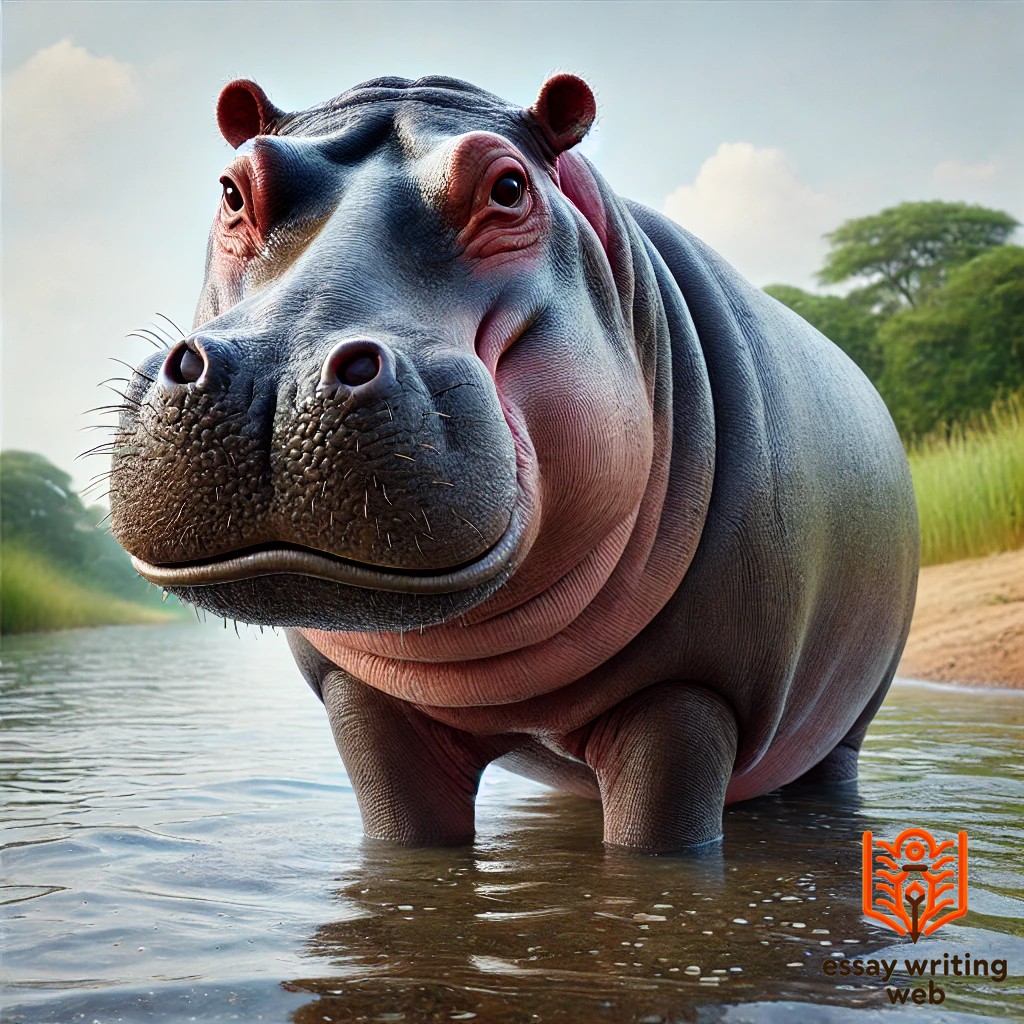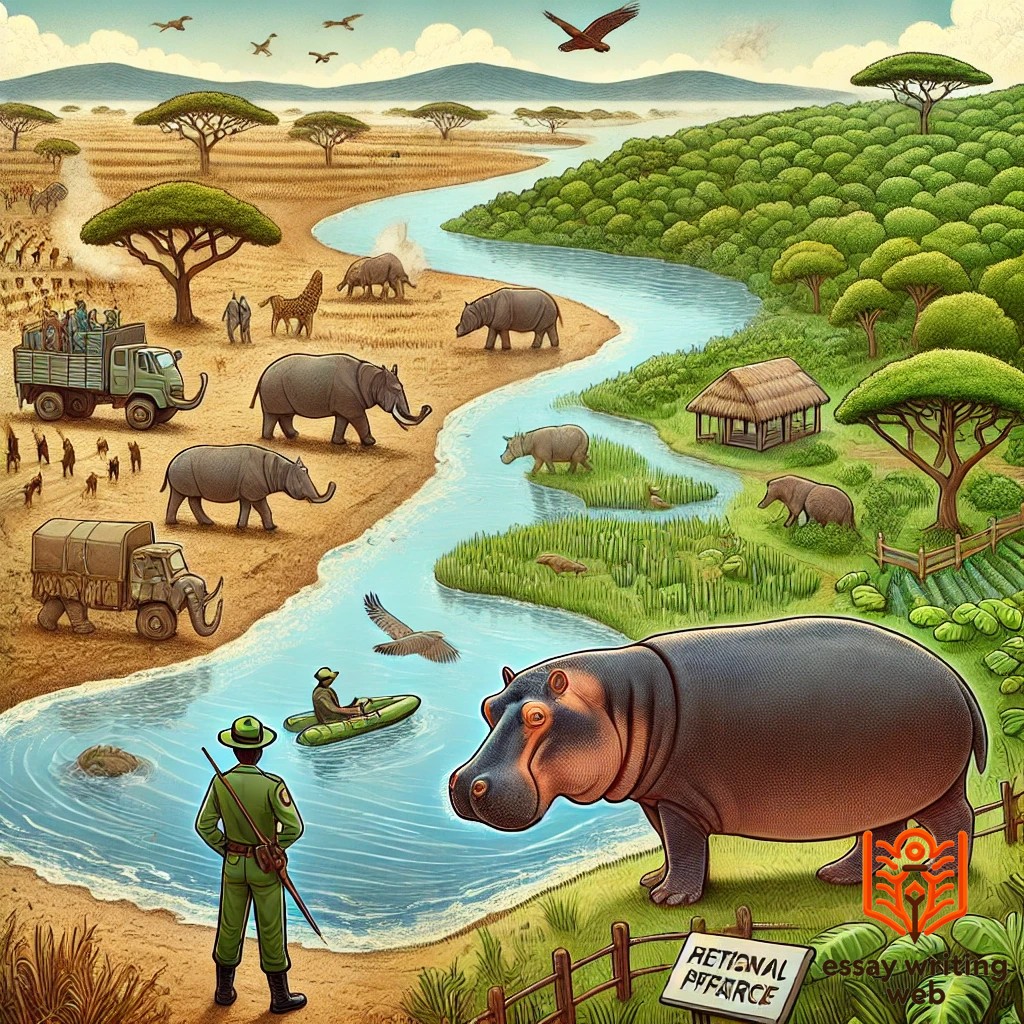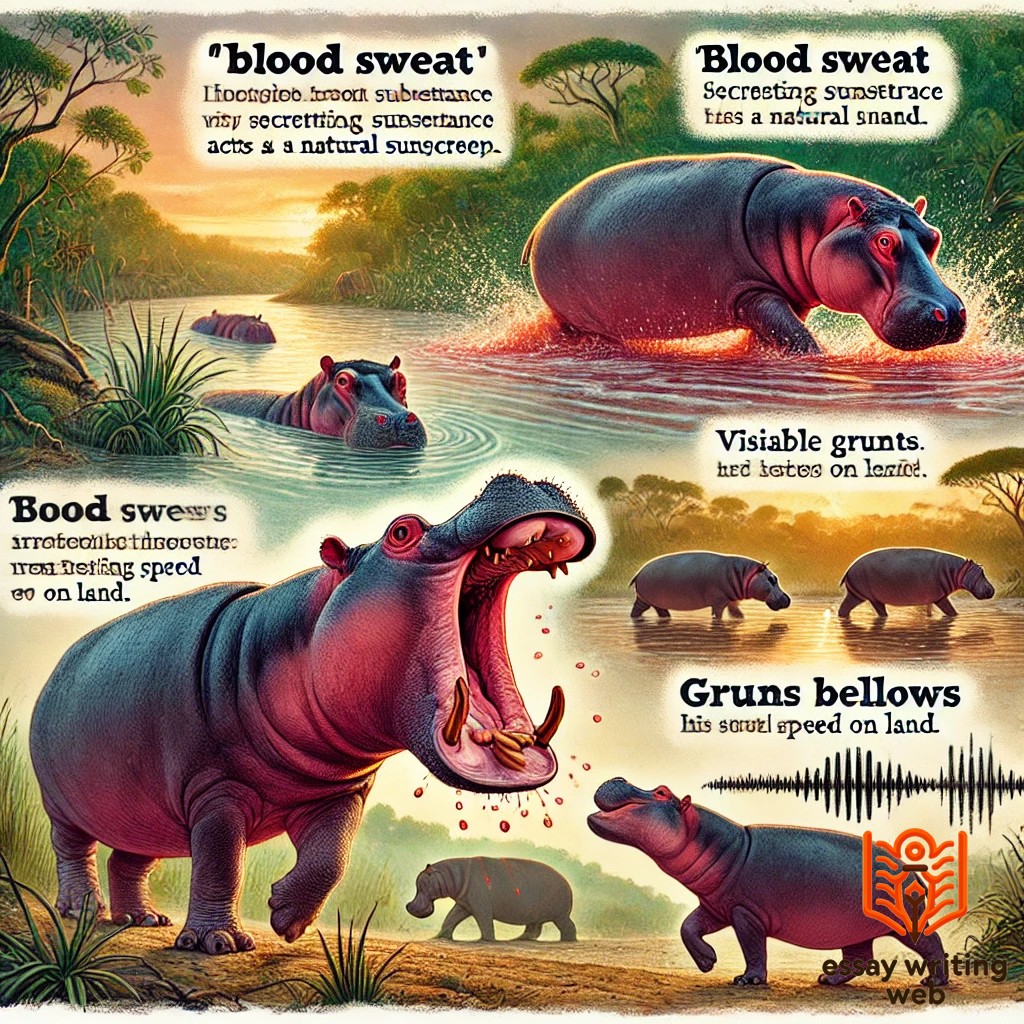 Essay Writing Web
Essay Writing Web

 19-09-2024
19-09-2024
 www.essaywritingweb.com
www.essaywritingweb.com
The hippopotamus, often referred to as the "hippo," is a large, semi-aquatic mammal native to sub-Saharan Africa. Its name, derived from ancient Greek, means "river horse," reflecting its close association with water. Despite its somewhat lumbering appearance, the hippopotamus is an impressive and highly adapted creature. Weighing up to 3,000 kilograms, it ranks as one of the largest land mammals, second only to elephants and rhinoceroses in size. Its stout, barrel-shaped body, large mouth, and powerful jaws make it an iconic symbol of the African wilderness.
Hippopotamuses spend most of their time in rivers, lakes, and swamps, which is essential for keeping their sensitive skin cool and hydrated. Unlike other large land animals, hippos are not covered in fur; instead, their thick, almost hairless skin secretes a natural sunscreen-like substance that protects them from the harsh sun. While they appear slow and docile, hippos are surprisingly agile both in water and on land. They can run at speeds up to 30 kilometers per hour on land and are highly territorial in the water, where they establish dominance through displays of their massive teeth and wide-open mouths.
Though primarily herbivorous, feeding mainly on grass, the hippopotamus is known for its aggressive behavior. It is considered one of the most dangerous animals in Africa, responsible for more human deaths than many of the continent’s more feared predators, such as lions or crocodiles. This aggressive nature, combined with their unique aquatic lifestyle, makes them one of the most fascinating creatures in the animal kingdom. Unfortunately, due to habitat loss and poaching, their populations are declining, making conservation efforts crucial to their survival in the wild.
The hippopotamus, known for its massive and distinctive physical appearance, is one of the largest land mammals. Its body is characterized by a large, barrel-shaped torso, supported by short, sturdy legs. Adult male hippos can weigh between 1,500 to 3,000 kilograms, with females being slightly smaller. Despite their enormous size, they possess a surprising amount of agility, especially in the water.
One of the most recognizable features of the hippopotamus is its large head, which houses an enormous mouth capable of opening up to 150 degrees. This wide gape reveals their long, curved canine teeth, which can grow up to 50 centimeters. These teeth, while often seen in displays of aggression, play a crucial role in maintaining dominance and protecting territory within their social groups.
Their skin, typically grayish to brown in color, is thick and virtually hairless, except for small patches of bristles around the face and tail. Their skin secretes a reddish, oily fluid often referred to as "blood sweat," though it is neither blood nor sweat. This substance acts as a natural sunscreen and provides some protection against infections.
A unique adaptation of the hippopotamus is its ability to spend extended periods in the water. Their eyes, ears, and nostrils are located on top of their heads, allowing them to see and breathe while mostly submerged. This adaptation enables them to remain cool in the hot African climate, while also staying safe from predators.
Overall, the physical characteristics of the hippopotamus make it a remarkable and well-adapted creature, perfectly suited for its semi-aquatic lifestyle.

Hippopotamuses, though commonly thought of as a single species, are divided into two distinct species: the common hippopotamus (Hippopotamus amphibius) and the pygmy hippopotamus (Choeropsis liberiensis). Each of these species has unique characteristics and adaptations that distinguish them from one another.
The common hippopotamus is the larger and more well-known of the two species. Native to sub-Saharan Africa, it primarily inhabits rivers, lakes, and swamps, where it spends the majority of its time submerged in water to stay cool. The common hippo can weigh between 1,500 to 3,000 kilograms and measures up to 16 feet in length. Its massive body, large mouth, and powerful jaws are some of its most recognizable features. Despite its size, this species is quite agile, both on land and in the water. Common hippos are social animals, often found in groups called "pods," which can include up to 30 individuals. Their territorial nature and aggressive behavior make them one of Africa's most dangerous animals.

The pygmy hippopotamus is a much smaller and rarer species, native to the forests and swamps of West Africa, particularly Liberia, Sierra Leone, and the Ivory Coast. Weighing between 180 to 275 kilograms and standing about 3 feet tall, the pygmy hippo is significantly smaller than its common counterpart. Unlike the common hippo, which lives in groups, pygmy hippos are more solitary animals, often living alone or in pairs. They are also more terrestrial, spending less time in water compared to the common hippo. Pygmy hippos have adaptations suited for their forested habitat, including more rounded bodies, longer legs, and less prominent tusks.

The habitat and distribution of the hippopotamus are closely tied to its semi-aquatic lifestyle. Hippopotamuses are primarily found in sub-Saharan Africa, inhabiting rivers, lakes, and swamps across the continent. Their range extends from West Africa to East Africa, with significant populations in countries like Zambia, Tanzania, Uganda, and South Africa. The availability of water is crucial for their survival, as they spend most of their time submerged to stay cool and protect their sensitive skin from the sun.
Common hippopotamuses prefer slow-moving rivers and lakes with ample water and nearby grasslands for grazing. They require these water bodies not only for cooling but also for social interactions. Hippos are territorial in water, where males establish dominance over particular areas. During the day, they stay submerged, often with only their eyes, ears, and nostrils above the surface. At night, they leave the water to graze on nearby grasslands, sometimes traveling several kilometers in search of food.
In contrast, the pygmy hippopotamus, which is native to West Africa, inhabits dense rainforests and swamps in countries like Liberia, Sierra Leone, and Ivory Coast. Unlike their larger relatives, pygmy hippos are more solitary and terrestrial, spending less time in the water and more time navigating the undergrowth of the forest.
The distribution of both species is increasingly threatened by habitat loss, human encroachment, and hunting. Conservation efforts are vital to preserving their natural habitats and ensuring the survival of these remarkable creatures across their range.

The diet and feeding habits of the hippopotamus are primarily herbivorous, centered around grazing on grasses. Despite their large size, hippos consume relatively small quantities of food compared to other herbivores. On average, an adult hippopotamus consumes about 40 to 50 kilograms of grass per night. They typically feed during the night, venturing from their water habitats to nearby grasslands in search of food. Hippos are known to travel several kilometers in search of suitable grazing areas.
Their primary food source is short, soft grasses, which they use their wide mouths and sharp incisors to clip efficiently. Though hippos are primarily grazers, they occasionally consume aquatic plants or other vegetation found near water. Interestingly, despite spending a significant amount of time in water, hippos rarely feed on aquatic vegetation.
Hippopotamuses have adapted their feeding habits to their semi-aquatic lifestyle. During the day, they rest in the water, conserving energy and avoiding the heat of the sun, and only begin their foraging activities after sunset. This nocturnal feeding behavior helps them stay cool while avoiding overexertion in the hot African climate.
While primarily herbivorous, there are rare instances where hippos have been observed scavenging or consuming carrion, although this is not common.

The social behavior of the hippopotamus is both complex and unique, particularly in the way it interacts within its aquatic habitat. Common hippos are highly social animals, living in groups known as "pods" or "herds," which can consist of 10 to 30 individuals, though larger groups are not uncommon. These pods are typically dominated by a single territorial male, while females and their offspring form the majority of the group. Male hippos are extremely territorial in water, fiercely defending their section of the river or lake against rivals.
Within the group, social hierarchies are maintained through displays of aggression, such as opening their large mouths to show off their powerful canine teeth. Despite this aggression in water, hippos tend to be more tolerant of each other on land, where they forage independently at night.
Communication between hippos occurs through a variety of vocalizations, including grunts, bellows, and even underwater sounds. These vocalizations help maintain group reinforce and cohesion social bonds. Additionally, physical gestures, such as marking territory with dung and urine, are common behaviors, especially among males.
While the common hippopotamus is highly social, the pygmy hippopotamus is more solitary, preferring a more reclusive lifestyle in its forested habitat. The complex social structures of hippos contribute to their dynamic interactions and survival in their natural environments.

The reproductive cycle of the hippopotamus is marked by unique behaviors and adaptations to its aquatic lifestyle. Female hippos reach sexual maturity around five to six years of age, while males become mature slightly later, around seven to eight years. Mating usually occurs in the water, where the female is submerged to support the weight of the male. This aquatic environment helps prevent injuries during the mating process due to their large size.
After a gestation period of approximately eight months, the female gives birth to a single calf, usually underwater. The newborn hippo, weighing between 25 to 50 kilograms, must quickly swim to the surface for its first breath. Although births can happen on land, water offers a safer environment for the calf. The mother and calf remain closely bonded, with the calf staying by its mother's side for protection and nursing for up to 18 months.
Hippopotamuses have a relatively long lifespan, living up to 40 to 50 years in the wild. In captivity, they may live even longer, sometimes reaching over 50 years due to the absence of predators and access to regular food and medical care. Despite their size and strength, hippos face threats from habitat loss and human activity, impacting their populations in the wild.
Their reproductive success and lifespan play a crucial role in maintaining healthy populations, making conservation efforts essential for their survival.

The hippopotamus, despite being one of the most iconic and formidable animals in Africa, faces significant threats to its survival. Habitat loss, poaching, and human-wildlife conflict are the primary challenges threatening their populations. As human populations expand, wetlands, rivers, and lakes—critical habitats for hippos—are increasingly being converted for agriculture, settlements, and infrastructure development. This leads to fragmentation of their habitats, limiting access to essential water sources and grazing areas.
Poaching is another major threat, driven by the demand for hippo ivory, derived from their large canine teeth. Although hippos are not targeted as frequently as elephants for their ivory, they still face illegal hunting in some areas. Additionally, hippos are hunted for their meat, especially in regions where other wildlife populations have been depleted.
Human-hippo conflict also poses a challenge. Hippos, particularly when they feel threatened or are defending their territory, can be highly aggressive, leading to dangerous encounters with local communities. These conflicts often result in retaliation against hippos, further reducing their numbers.
Conservation efforts are essential to protecting hippopotamuses. Many countries have established protected areas, such as national parks and wildlife reserves, where hippos can thrive in relatively undisturbed environments. Additionally, international laws, such as the Convention on International Trade in Endangered Species (CITES), regulate the trade of hippo ivory and other body parts.
Raising awareness about the importance of wetland preservation and mitigating human-wildlife conflicts through education and sustainable practices are crucial to ensuring the survival of this remarkable species for future generations.

The hippopotamus is a fascinating animal with many unique and interesting characteristics. Despite their bulky, lumbering appearance, hippos are surprisingly agile. They can run at speeds of up to 30 kilometers per hour on land, faster than some humans. Though semi-aquatic, hippos do not swim in the traditional sense. Instead, they walk or push off from the riverbed in a graceful, almost weightless manner.
One of the most remarkable traits of the hippopotamus is its ability to secrete a reddish substance often referred to as "blood sweat." This natural secretion acts as both a sunscreen and a form of protection against infections, helping to keep their sensitive skin cool and hydrated.
Though primarily herbivorous, eating grasses and plants, hippos have been observed engaging in unusual behaviors such as scavenging, which is rare among plant-eaters. They have also been known to defend their territory aggressively, making them one of the most dangerous animals in Africa, despite their plant-based diet.
Another interesting fact is that hippos are considered one of the noisiest animals in the wild. They communicate through a variety of vocalizations, including grunts, bellows, and even underwater clicks, which can travel long distances. These sounds help them maintain social bonds within their groups and protect their territories.
With these intriguing behaviors, the hippopotamus continues to captivate wildlife enthusiasts around the world.
